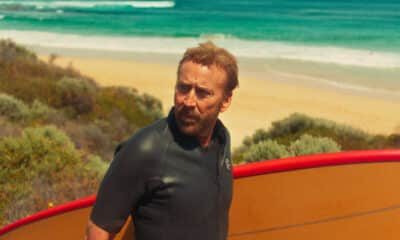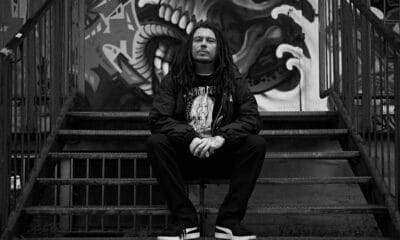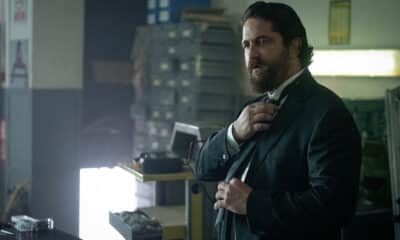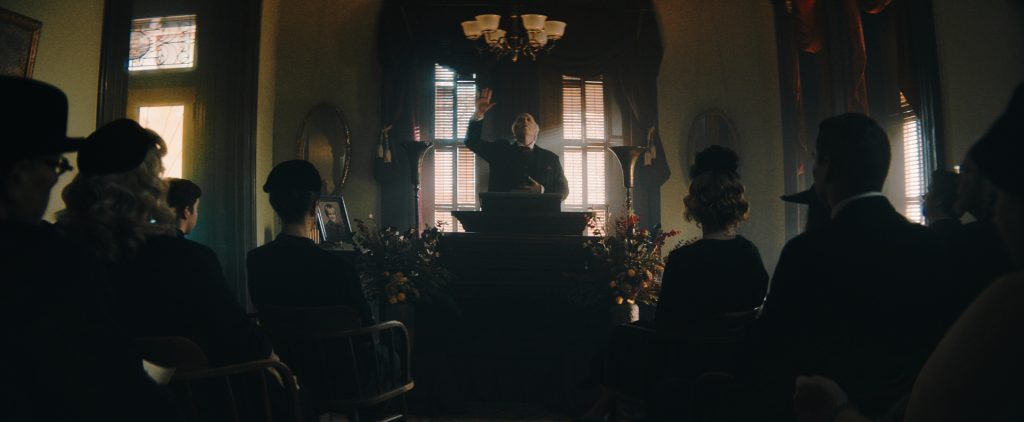
From this Thursday evening until Saturday night the GFF ventures into the darker side of cinema with its annual Arrow Video Frightfest takeover. Over the course of the two and a half days, the event will host a total of thirteen movies that cover all facets of genre cinema. One such film is The Mortuary Collection. Screening on Friday 6th March at 10:50 PM, the film is the first time feature from writer-director Ryan Spindell.
Despite being his first feature-length film, Spindell has been steadily working in the world of short films for the last few years. In fact, one of his shorts, The Babysitter Murders, forms part of The Mortuary Collection which in itself is a portmanteau anthology. The film begins in a funeral home, the perfect setting for hearing some scary stories, and sees Clancy Brown’s Montgomery Dark recount some rather disturbing tales to a prospective co-worker. It’s a movie that taps into the magic of the bygone era of great anthology films; the ones that had a single mind at the helm, rather than being a collection of cool shorts from new filmmakers.
Ahead of the screening at Frightfest, we took time out with Ryan to delve a little deeper into the production process, lament the lack of child-friendly horror shows, and bond over an appreciation of Pet Sematary 2.
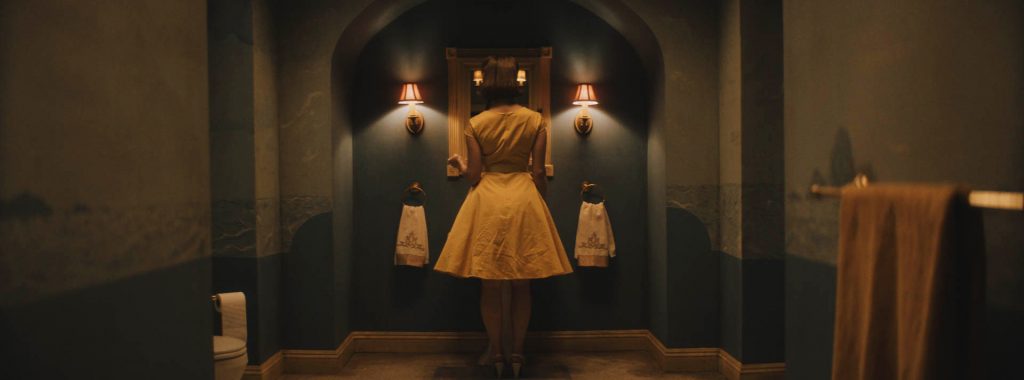
How did you get into making films?
So I grew up in a really rural part of the US, in Northern Maine, on the coast near Canada. I didn’t have any exposure to film as being an actual career path that you could take. It was just something I loved to watch, so it wasn’t until high school [that I got into it]. I was also kind of a wimp growing up as far as movies go. The horror genre, in particular, I would avoid like the plague. I was just terrified. Even the Garfield Halloween special would freak me out. I would watch it, but really reluctantly every year. I spent a lot of my time growing up in the arts. I wanted to be a cartoonist when I was a kid and I drew a lot. I painted a lot and I would put on little sketches, and I would build stuff; I was a really hands-on artist type.
In high school I got two movies from a friend of mine, one was Sam Raimi’s Evil Dead 2, and the other was Peter Jackson’s Dead Alive. Both horror movies, and both at a place where I still didn’t want to watch them because I was scared of them. But everyone was talking about them so I started watching them. I watched them both on the same day and I remember it was like a light-bulb going off in my head. I didn’t realise horror was such an artistic genre. I’d always imagined horror as being kids getting chopped up in the woods. Just gratuitous blood and guts. Then I’m watching Dead Alive and I’m watching The Evil Dead 2 and I was just seeing these super nerdy fine artists just exploding with creativity from every single frame. The colour, and the art and the performances…I just saw how robust a medium it was. I just remembered that particular day being, “oh horror can be beautiful and outrageous and something wholly unique”. I just knew from that day that I wanted to do ‘that’. I didn’t know how to do that, but I wanted to be the person that did that.
The Mortuary Collection is told in the portmanteau style, rather than the ordinary anthology which tends to have a story or idea that doesn’t necessarily link them, it’s just pages in a book or a series of videotapes. How important was it that you did it in that style so that the connecting story is just as, if not more, important than the stories?
It was the most important thing for me. I love the format. First off, I’m sad that it’s a format that’s kind of gone away. I know it’s having a little bit of a resurgence, especially with these aggregate style films like the V/H/S movies. Which I enjoy, but they’re not like a single filmmaker’s vision. They’re more, “hey let’s give a bunch of cool people like twenty thousand dollars and see what they do.” That’s fun, but I feel that it makes people forget a little bit about this concept of one idea/vision/story. I think it’s very rarely been done. I remember the old Amicus films were pretty good at having strong wraparound stories that tied everything together, but I feel like lately, it has become a lot less important. Some movies even go to the point of just going to black between, which I think is just such a missed opportunity. If you’re a creator and you’re building a world, and you have all these different stories to tell…if you want to make one-off short films, that’s fine. But I think if you want to make a feature film it’s something that’s going to latch people in for one to two hours of run time, I feel like you’ve got to put a little bit more in. I think that was sort of the drive to do it. Then the thing that I tried to set myself up for was, whether I succeeded or failed, was to try and find a wraparound story that really was the movie. Instead of it being a wraparound story that was an afterthought or bookend; I wanted the wraparound to be the beating heart of the film, and the segments to be the one-offs.
You’ve previously worked on shorts, this is your first feature film. The fact that the film has these shorts within it, did that help in the transition from short format to long?
I think it did, and it didn’t. It did in the aspect that I knew how to how to execute a short, and how to make something that felt bigger than it was on a small budget. I was able to get a little bit of money and start building this thing piece-by-piece. So in that aspect, absolutely. It allowed me to pull the trigger. This whole thing started with…so the fourth short in the feature is called The Babysitter Murders, and it’s sort of a slasher movie. We actually Kickstarted it five years ago and raised a little bit of money and properly made that independently. It allowed me to dive in and get started, and that’s definitely the hardest part about film-making. Once you get started, you’re going to finish, but pulling the trigger, that’s tricky.
I will say that when it comes to making your first feature film, I would highly recommend that nobody try to make five films all at once. Instead, just focus on one. I was looking at it logistically as a producer like, “okay, if I can get a little bit of money, then I can make a piece. Get a bit more and make another one. I can build something really robust over time.” But just the sheer energy it takes to do that again and again and again, and especially once we had a bit of money to make the whole feature, we were now on a deadline. We couldn’t just make it how we wanted to make it, and find the right location and right people; we had to steam-roll forward. So in a weird way even though we had a significant amount of money, more money on the feature than we had on the short, the first short was a much more robust experience. I had more days, more equipment because we pieced it together and called in all our favours. The rest of it was like a race to the finish line to finish off all these different stories.
For a traditional independent film or first time film, you get two or three actors and maybe one great location and just do a cool movie. We had to do that five times; five sets of actors, five great locations, and then there are period pieces and within that nothing could be shot as is, everything had to be painted, or modified, or built from scratch. It was an insane thing to try to do that. I didn’t quite know how impossible it was going to be until I was too far in it to back out. At the end of the day I’m so proud of the movie and I really, really do love it thoroughly. But if I knew what I was going to have to go through to actually bring it over the finish line, it’d be really tough for me probably to pull the trigger.
The film has a very distinct visual aesthetic to it, it’s almost very definitely set within a certain time period, but could also be happening at any point in time. The look, that very timeless aesthetic, can you talk a little bit about how you came to want to shoot in that way?
Sure. When I was growing up, I wouldn’t watch horror, but the one thing I would watch because it was one of my dad’s favourite shows and we would watch it together, was the original Twilight Zone. I think that there’s an aesthetic of that series that’s been ingrained in my brain as this timeless period where allegories can play out through genre.
I do think that there’s something important about these short-form stories, especially when they’re taking some pretty wild swings and they’re going to some pretty strange places, it’s nice to give the audience a little bit of separation. So it feels like it’s in our world, but just a few degrees off, to the point where we don’t nitpick all the different aspects of it. I wanted it to feel like, ‘I know this is Earth, but it’s not – I’m just going to enjoy the story and not overthink it.’ For me the best campfire stories are timeless. That, combined with the idea that anthologies are campfire stories, they’re people sitting around and falling in love with stories, and storytellers, and the format. When you sit around and tell the story with the hook hand hanging on the doorknob – there’s not a time period associated with it. It just ‘is’. It could be in the fifties, it could be yesterday. I think I wanted to create that feeling in the movie.

That definitely comes across; they could be set in almost anytime. But also as they progress, they almost seem to be getting more modern.
That’s true. A big challenge we had with that timelessness is that there was a lot of music planned for the film. I worked really closely with these composers and musicians, and one of the things that we started the project off with was that every short is going to have a totally original music cue that was going to be an integral part of it. Then when we get to the college students we were like, “how do we write a rock song that feels timeless, but at the same time has this fun youthful feeling that we want people to experience?” That was a challenge… to find these timeless songs as well as aesthetics.
It might be your first-time feature, but you managed to snag Clancy Brown. How did he get involved?
I think the best thing for the project was that we had made that short prior. The short is so specific, and it did really well on festivals. So what we could do is send this short directly to any collaborators – this is across the board – special effects artists, actors, musicians, anyone. We could show them this instead of just white papers with text and the hope that they would get our non-traditional aesthetic. We could say, “look, here are twenty minutes of the film”, and that honestly went a long way to getting people who would normally be out of our league, especially with how low our budget was for the overall film.
Beyond that Clancy was just the classic… it’s interesting to think about the timeless question we were just talking about because I feel like I also wanted to cast the movie with people that we recognise and know, but we don’t quite know from where. Just to throw people off. Clancy’s always been – I love character actors – and Clancy’s always been this guy popping up in all these amazing things. I remember when he read the script and agreed to meet with me, I was scared shitless because I’d never done the whole go meet a famous person at a diner, and convince them to do the movie before. And of course, he’s like 13 feet tall, and has this huge baritone voice, and is a little intimidating. But within three minutes of sitting down with him I was like, ‘Oh, he’s my people.’ He’s like a big genre nerd, he reads non-stop, he’d got tons of ideas. He’s so cool and we’re still friends today, which has been one of the best things to come out of the movie.
He’ll always be Gus from Pet Sematary 2 for me…
It’s funny because he’s done all these prestigious films, but Pet Sematary 2 is the thing I know him from most as a kid because I watched it like a million times. In the first meeting with him, I was dancing around thinking, “do I bring up Pet Sematary 2? Is that a film he’s proud of or not?” I was real coy about it, but then he loved it. He loves to play. That’s the thing. I think a lot of these actors get stuck in the same thing again and again so anytime you can give them the opportunity to get weird; that’s what The Mortuary Collection was. I was like, “look I’m going to put you into prosthetics, it’s going to be a pain in the ass, and it’s going to be this weird eccentric character”, and he was just, “bring it on”, which is always really fun.
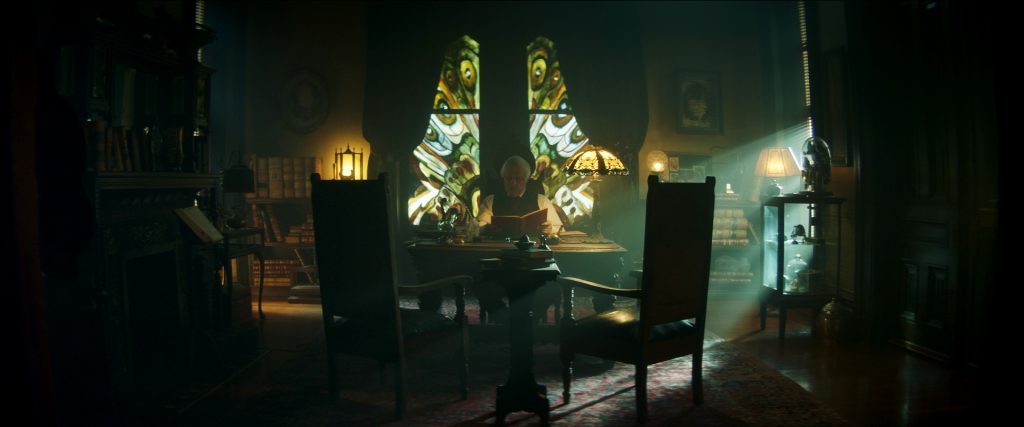
I thought the world and concept of The Mortuary Collection was great, a little bit like a darker Scary Stories to Tell in the Dark. Would you ever consider returning in the future to expand upon it?
I would love to. It’s interesting that you talk about that too because I don’t know if I intended it to be this way, but The Mortuary Collection has a bit of a kitchen sink to it. In that, I kind of threw everything I love about horror into it. I think maybe that was one of the things that was appealing about doing an anthology – being able to do a monster movie, do a slasher movie, do a ghost story, and to play in all these areas.
But I also just love Are You Afraid of the Dark, I love Goosebumps. I love that younger kind of fantastic horror that we don’t see that much. So I stuck that in there too. You go into making a movie and you put all of your heart, and all of these things that you love into it, but you don’t really anticipate, “oh is this going to work for a general audience?” Am I getting too niche? Or disperse with all these different types of ideas that are going to throw people off. I think sometimes it does. I think there are a lot of horror fans, and I have a lot of friends, who like their horror one way; they like it very straight and scary and very dark. It’s kind of a risk to make a movie that has fantasy elements, and things that are a little bit more ‘spooky’ as opposed to scary. That’s something that we’re learning as we roll out with this film, how do you market a film that taps into all of these different sub-genres within the genre, beyond just the people like me that just like everything. I just like anything that’s different. Whenever I start to see the same thing, again and again, I think, “what’s a different way to see this.” I want to be surprised a little bit.

The original seed of it was that I wanted it to be an ongoing series. I moved to LA and I wanted to get the rights to make Creepshow or Eerie, Indiana, or Tales from the Crypt, or Twilight Zone. I wanted to go after those shows. I was knocking on these doors, trying to find out if there was any way to do it and everybody was, “look, kid, no one’s going to give you one of these huge IPs. You’re a nobody”. So I thought maybe I can make a movie and create something of my own, and use that to spin-off into a series. That was the initial thrust for making it.
I have so many of these stories on my computer just gathering dust. It’s kind of a bummer to be so passionate about short form, because right now – and this might be changing – but for right now there’s not really any place to actually make those things and survive as an adult doing so. You kind of just have to save up all your money and you make them, then you do the film festivals and you meet a bunch of cool people, and then you go back to your day job. The idea of an anthology TV series is the ultimate dream. I still feel like I haven’t seen one that’s really knocked my socks off, except for maybe the first couple of seasons of Black Mirror. But yes, there are so many more stories that I would kill to have the opportunity to explore.
There is a gap in the market – I grew up on Eerie, Indiana, Are You Afraid of the Dark.
I was just watching an expose on spooky shows/series for kids that were in the early nineties, and how in the 2000’s they just stopped making them cold. There was almost zero content being made in that arena because, for one reason or another, people had decided that they weren’t good for kids. They just went off of the air altogether. It was just diving into whether that’s a negative thing. Horror, in whatever format, helps kids…I’m trying to remember what the quote was in the video. It was something like “everyone knows evil is there from the time we’re born. It’s just burned into us. But horror, especially children’s horror, shows us that evil can be defeated.” That’s why it’s important for kids, and in the 2000’s it just went away. I didn’t notice it because I was in my twenties around then so I stopped paying attention to what was being made for kids. But you’re right… where are these shows now?!
Catch The Morturay Collection at Arrow Video Frightfest on Friday 6th March at 10:50PM.
Kat Hughes is a UK born film critic and interviewer who has a passion for horror films. An editor for THN, Kat is also a Rotten Tomatoes Approved Critic. She has bylines with Dread Central, Arrow Video, Film Stories, and Certified Forgotten and has had essays published in home entertainment releases by Vinegar Syndrome, Arrow and Second Sight. When not writing about horror, Kat hosts micro podcast Movies with Mummy along with her six-year-old daughter.

Latest Posts
-
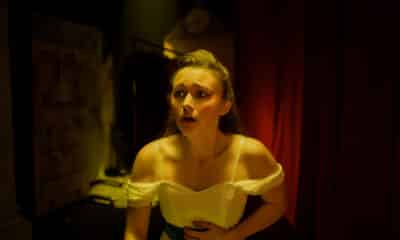

Film Reviews
/ 2 days ago‘Fear Street: Prom Queen’ review: Dir. Matt Palmer (2025)
It has been four years since Leigh Janiak’s Fear Street trilogy took horror fans...
By Kat Hughes -
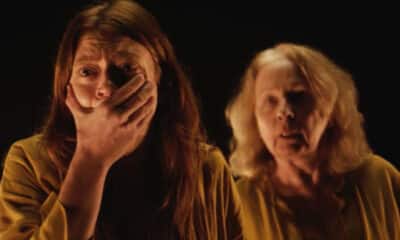

Film Reviews
/ 2 days ago‘The Surrender’ review: Dir. Julia Max (2025)
As Julia Max’s debut feature, The Surrender, unfolds, the inspirations for the film become...
By Kat Hughes -
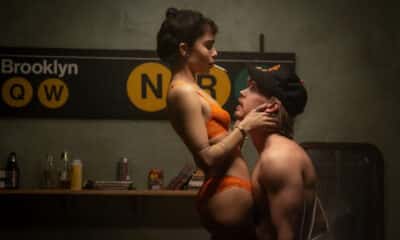

Film Trailers
/ 4 days agoFirst trailer for Darren Aronofsky’s ‘Caught Stealing’
Sony Pictures has released the debut trailer for Darren Aronofsky’s new film Caught Stealing,...
By Paul Heath -
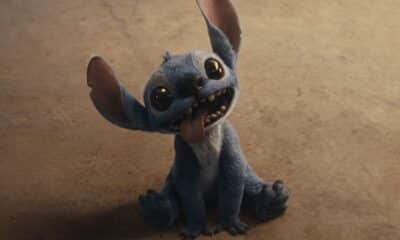

Film Reviews
/ 5 days ago‘Lilo and Stitch’ review: Dir. Dean Fleischer Camp (2025)
Director Dean Fleischer Camp won audiences over with the fantastic Marcel the Shell with...
By Kat Hughes
